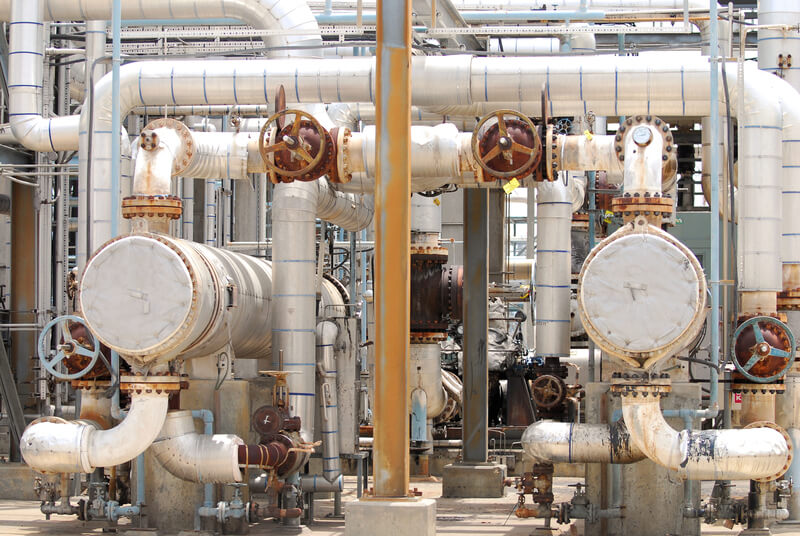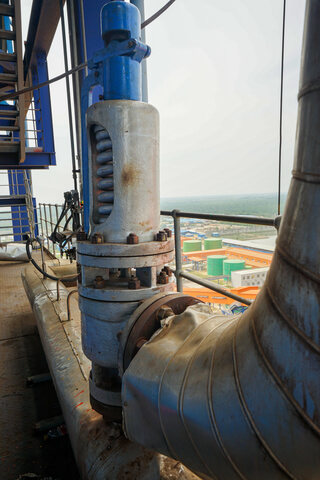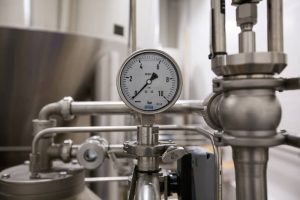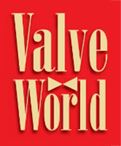Pressure relief valves (PRVs) are designed to protect boilers, pressure vessels and piping and are considered the “last line of defence” within industrial processes. However, an industrial process must operate in such a way that there is the highest possible productivity and in accordance with its design. In order to achieve this productivity, process operators in many companies end up working with the operating pressure very close to the valve opening pressure, causing leaks through its sealing surfaces.
By Artur Cardozo Mathias

Maximum recommended operating pressure
The operating pressure is the normal gauge pressure to which a pressure vessel or boiler is subjected constantly and without any considerable variation. The user’s process engineer is the professional responsible for determining the maximum operating pressure of the vessel or boiler that will be purchased. These equipments are normally designed to have a Maximum Allowable Working Pressure (MAWP) that provides a margin above the maximum expected operating pressure to avoid any undesirable operation of the pressure relief device(s) caused by the smallest fluctuations in that pressure. Therefore, vessels and boilers are designed to operate with the maximum possible efficiency and at an operating pressure very close to their MAWP. In order for the PRV to have its complete operating cycle (opening, overpressure and closing), and still remain closed and sealing, the normal operating pressure of the protected equipment (vessel or boiler) must not be above 90% of the valve opening pressure, if the fluid is compressible (gas or vapour), or 80% if the fluid is liquid, for valves with metallic sealing surfaces. For those with resilient seats and operating with gases and vapours, that operating margin could be as low as 5% below its opening pressure, however, the PRV closing pressure will occur at approximately 7% below its opening pressure, therefore, it is not recommended to operate with such a low margin since when the valve opens it will not close again, unless the operating pressure of the vessel is reduced. Pilot operated PRVs can operate up to 3% below their opening pressure. A value of 90% of the opening pressure for spring-loaded valves with metal seats or 95% for resilient seats and pilot operated valves, is common in selecting the maximum operating pressure. The ASME Section VIII – Division 1 (Edition 07/2025) code, in Appendix M10 (c) – (Non-Mandatory), recommends the following values as minimum differential pressure between the vessel operating pressure and the valve opening pressure:
- 5 psi (0.34 bar) for opening pressures up to 70 psig (4.82 barg);
- 10% below the opening pressure for pressures above 70 psig (4.82 barg) and up to 1000 psig (68.9 barg);
- 7% for opening pressures above 1000 psig (68.9 barg).
It is due to the values mentioned above that the sealing surfaces of the valve disc and nozzle must be lapped with extreme flatness and a “mirror finish” to ensure maximum tightness with low pressure differential and forces. If the operator wishes to reduce the valve opening pressure, the recommended minimum operating margin should not be reduced to avoid leaks.
Note: A reduction in the valve opening pressure causes an increase in the fluid volume, if the fluid is compressible, so the valve may be undersized for that new pressure. Before reducing that pressure, the valve should be resized to confirm that the current nozzle passage area (orifice) will continue to meet the new fluid volume. Therefore, the “new” desired opening pressure should be within the spring adjustment range defined by the manufacturer, or the spring should be replaced if that orifice continues to meet the “new” volume, or the PRV should be replaced with one with a larger orifice if the current orifice does not meet the “new” volume. With the operating pressure very close to the PRV opening pressure, in addition to causing leaks through the sealing surfaces of the disc and nozzle, it can also cause vibrations that will result in loosening of some components that are tightened, such as the spring adjustment screw lock nut, nozzle and guide ring lock screws (when applicable), among others.
Note: The Alphabetical Appendices of the ASME Section VIII – Division 1 Code are Non-Mandatory, that is, they are considered only “Good Engineering Practices”. Therefore, through Appendix M10, the code recommends those operating margins to the end user. With the operating pressure very close to the valve opening pressure, it can cause vibrations and excessive fluid leakage; consequently, depending on the product of this leakage, it can lodge in the clearances between the disc, the valve support and the valve guide.
The disc and valve guide can cause a hard lockup and render the valve inoperative. Steam leakage itself can cause this lockup due to the temperature differential. Different construction materials for the disc support and the guide can also cause lockup due to the resulting galvavnic corrosion.
In spring-loaded PRV designs, small amounts of leakage can be expected when the operating pressure of the vessel or boiler stabilises or peaks above 90% of the valve opening pressure.
The use of a flexible disc for steam, especially in high-pressure boilers, allows the operating pressure to be closer to the valve opening pressure, which can be as close as 5% below the opening pressure, although the blowdown of these high-pressure valves is only 4%. This disc design is recommended whenever the fluid temperature is above 560°F (293°C), even for pressure vessels.
Pressure relief valves operating with liquids

PRVs operating with liquids must have a larger operating pressure margin. These valves have a higher blowdown value, i.e., the valve closing pressure is further away from its opening pressure and closer to the vessel’s operating pressure. Values of 5 psi or 10% are recommended for fluids such as gases and vapours. It should be noted that PRVs that operate with liquids or those installed in the discharge of pumps and compressors, or downstream of a pressure reducing valve, in all these applications the minimum operating margin must be 20% of the valve’s opening pressure. Therefore, it is recommended that the valve be installed further away from these equipments, i.e., in a more stable pressure and flow region, for example, at a distance of 8 to 10 nominal pipe diameters.
This recommendation is due to the fact that PRVs operating with liquids, in which the operating pressure remains above 80% of the opening pressure, will be subject to not closing correctly after actuation. Therefore, under normal operating conditions, a minimum pressure differential of 20% must be maintained to compensate for any oscillations in the process that may occur in the operating pressure.
Note: For toxic or valuable fluids (liquids or gases), the process may require a higher differential pressure between the operating pressure and the valve opening pressure, or the use of a resilient seat on the disc, if the opening pressure, valve nozzle area and fluid temperature allow it. Each time the PRV operates, the process will be losing fluid, if it cannot be reused.
When operating with liquids, PRVs have a gradual pressure increase above the opening pressure until reaching the maximum overpressure for which it was designed. The value of the valve closing pressure will be proportional to the overpressure reached above the opening pressure under relief conditions.
Differential pressure between closing pressure and operating pressure

This minimum margin of 10% or 5 psi also ensures valve closing. Therefore, the maximum operating pressure should be limited to at least 3% below the valve closing pressure. Operators who allow the process to operate at operating pressures above this recommended margin do not realize that when the valve needs to open, it will not close later. Having the system operating pressure above the valve closing pressure can prevent it from closing properly. When this happens, the operating pressure must be reduced to allow the valve to close. Therefore, it is always recommended that the valve closing pressure does not collide with the equipment operating pressure. By increasing the pressure differential between the operating pressure of the protected equipment and the valve opening pressure, the possibility of leaks and/or premature openings is avoided, and consequently, spring and bellows fatigue (when applicable), in addition to wear on the sealing surfaces and sliding surfaces of the guide with the disc support. The leak of saturated steam, for example, is very damaging to the valve due to the erosion caused on its sealing surfaces due to the moisture present in this type of steam. Therefore, a greater number of interventions for valve maintenance may be necessary, however, this may cause unexpected process shutdowns, resulting in operational losses.
The valve’s operation itself, even if its opening pressure is well above the equipment’s normal operating pressure, may cause leaks due to possible impurities that may be contained in the fluid, damaging the sealing surfaces of the disc and nozzle after it opens.
If the fluid is compressible and the operating pressure stabilizes above 97% of the valve’s opening pressure, we will have a continuous leak called simmer, which is high seriously damaging to the valve sealing surfaces. Note: In applications with multiple PRVs, it is permitted that the second or last valve (if the equipment is protected by more than two valves) can be adjusted to open above the MAWP. How much this second or last valve can open above the MAWP depends on the equipment’s construction code and the causes of the pressure increase. Therefore, since the opening pressure value of this second valve will now be above the MAWP, there will be a greater operating pressure margin, consequently, less chance of leaks.
Scratches and scratches in the vertical direction on both the disk holder shaft and the guide bore indicate that the valve was exposed to an operating pressure very close to its opening pressure.
Note: PRVs that operate on high-temperature water boilers or in services with organic fluids are more susceptible to leaks than those that operate with saturated or superheated steam. For these applications, the highest possible differential pressure between the valve opening pressure and the boiler operating pressure is always recommended, as long as its values are compatible with the safety and cost of the equipment.
Conclusion
The operating pressure of the protected equipment should be limited to 90% of the valve opening pressure whenever the process fluid is compressible, or 20% if the fluid is liquid, thus avoiding damage to the valve and even loss to the process due to a possible unexpected shutdown for PRV maintenance and fluid losses.
When operators respect the recommended operating margin, according to the process fluid and valve design, associated with a regular inspection, the maintenance task becomes easier, and the valve’s useful life is also extended. Thus, the maximum operating pressure is the one that is commonly adjusted based on some percentage of the protected equipment’s own MAWP in relation to the valve opening pressure to avoid premature (unexpected) actuation of the valve or constant openings, in addition to allowing for normal process pressure fluctuations due to consumption variations, etc.
 About the author
About the author
Arthur Mathias is an industrial mechanical and chemical technician and a Member of ISA. Now a consultant, he has been active since 1985 in the maintenance, inspection, specification and sizing of valves. Arthur provides training and technical courses, and is the author of Válvulas: Industriais, Segurança e Controle published by ARTLIBER EDITORA.
About this Technical Story
This Technical Story is an article from our Valve World Magazine, August 2025 issue. To read other featured stories and many more articles, subscribe to our print magazine. Available in both print and digital formats. DIGITAL MAGAZINE SUBSCRIPTIONS ARE NOW FREE.
“Every week we share a new Technical Story with our Valve World community. Join us and let’s share your Featured Story on Valve World online and in print.”


 About the author
About the author